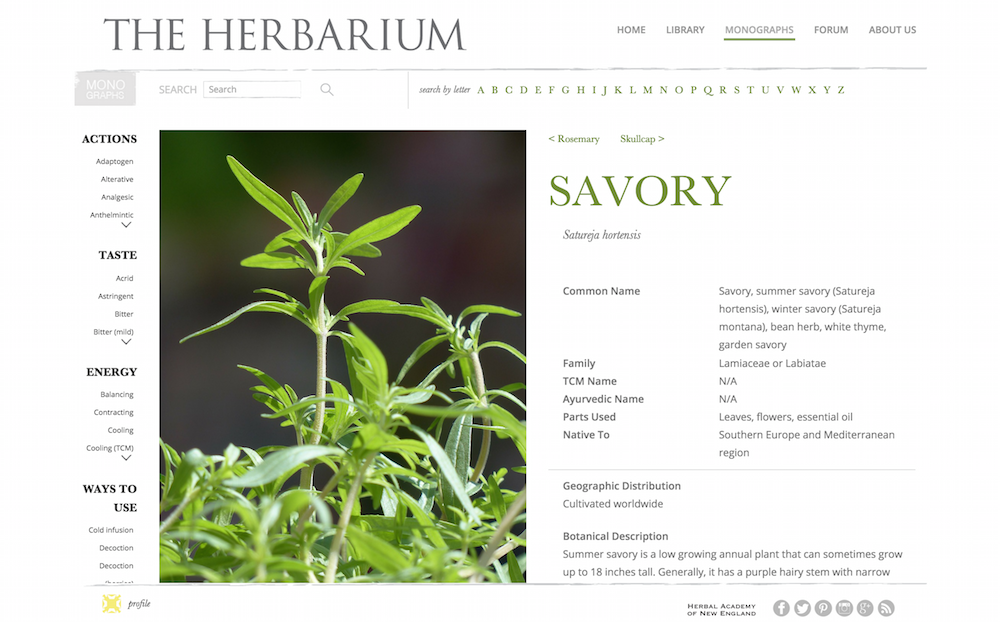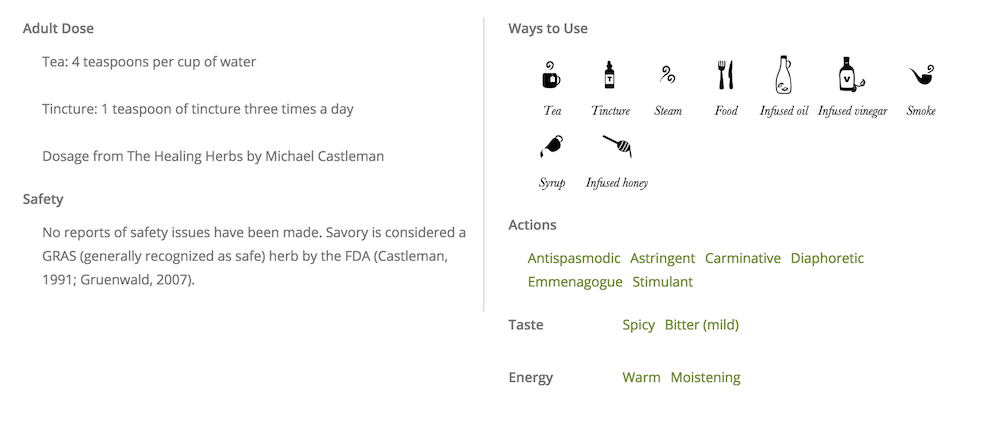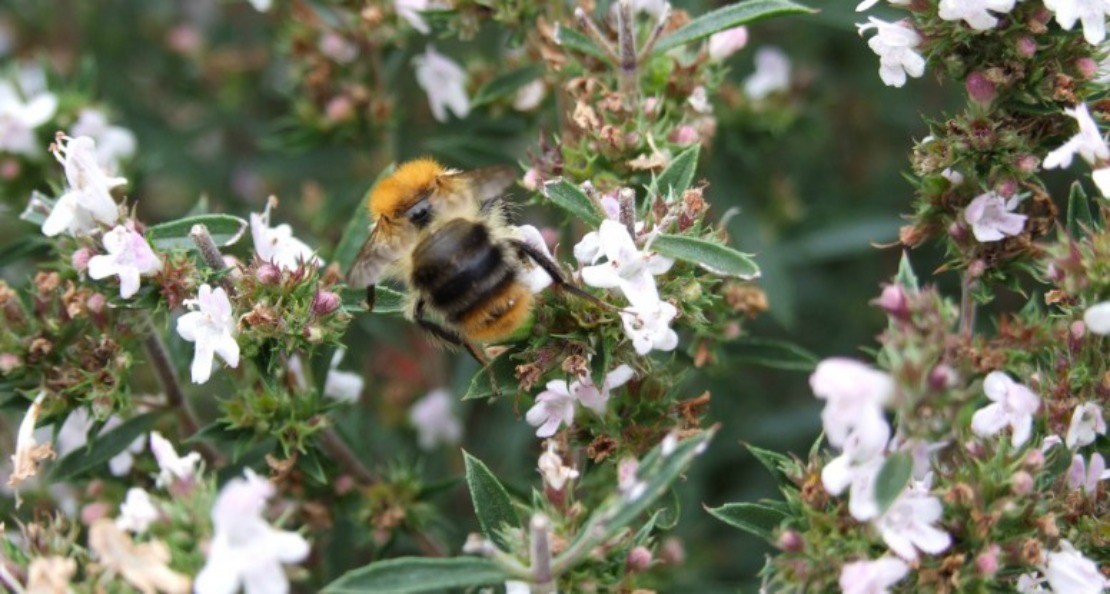
Celebrate HerbDay with Herb of the Year™: Savory Monograph
To draw attention to HerbDay 2015, we are celebrating with the reveal of our Savory monograph from The Herbarium, which just so happens to be this year’s International Herb Association’s Herb of the Year™. HerbDay is an international celebration of herbs and herbal products, conceived of by five nonprofit organizations: American Botanical Council, American Herbal Pharmacopoeia, American Herbal Products Association, American Herbalists Guild, and United Plant Savers. The goals of HerbDay will be met when key industry members and the herbal community join together to present a nationwide message that is cohesive, honest, and positive about herbs and herbalism.
The following Plant Monograph is excerpted from our herbalist membership website, The Herbarium. The Herbarium plant database includes some of the most beautiful and complete monographs to date, pulling together traditional herbal wisdom, hands-on experience, and modern scientific research to present a multifaceted description of each herb. See below for an excerpt from The Herbarium’s Savory monograph.
Savory
Satureja hortensis, S. montana
Common Name:
Savory, summer savory (Satureja hortensis), winter savory (Satureja montana), bean herb, white thyme, garden savory
Family: Lamiaceae or Labiatae
Parts Used: Leaves, flowers
Native To:
Summer savory’s native range is southeastern Europe to southwestern portions of Siberia (Royal Botanic Gardens of Kew [RBGK], n.d.a). Winter savory is native to the Mediteranean region, from southern Europe to Lebanon and Turkey (RBGK, n.d.b).
Geographic Distribution: In addition to its native region, summer savory has been introduced in parts of central and eastern Europe, the United States, and the Caribbean (RBGK, n.d.a). Winter savory has been introduced in Portugal and Texas (RBGK, n.d.b).
Botanical Description:
Summer savory is a low-growing annual that can reach up to 18 inches tall. Generally, it has a purple hairy stem with narrow leaves. Summer savory flowers are small white to pink blossoms; they flower from midsummer to the first fall frost, when they should be cut and dried for winter use. Summer savory prefers moist soil and grows well in containers and from seed (Castleman, 1991). Summer savory (or garden savory) is more commonly grown and used (Grieve, 1931/1971).
Winter savory is a smaller, woody bush that grows up to 12 inches tall. It has similar leaves as summer savory, but they appear darker. Winter savory flowers are white to lavender-colored and bloom mid-to-late summer. It prefers full sun and dryer soil and can tolerate temperatures down to about 10 degrees Fahrenheit (Shiffler, 2019). When growing from seed, it may be slow to germinate. The leaves can be cut and used fresh when they reach 6 inches tall (Castleman, 1991). It is recommended to grow savory near beehives, as the flowers attract bees and repel undesirable insects (Grieve, 1931/1971).
Key Constituents:
Summer savory: Volatile oils (e.g., carvacrol, p-cymene, alpha-thujene, alpha-pinene, beta-myrcene, alpha- and beta-terpinene, caryophyllene, and thymol), tannins (“Savory,” 2007), phenolic acids (rosmarinic acid and chlorogenic acid), and flavonoids (Hamidpour et al., 2014; “Savory,” 2007).
Winter savory: Volatile oils (e.g., thymol, p-cymene, caryophyllene, carvacrol, geraniol, and borneol), triterpenic acids (ursolic and oleanolic acids) (Hamidpour et al., 2014), phenolic acids (rosmarinic acid, caffeic acid, p-coumaric acid, ferulic acid, protocatechuic acid, syringic acid, vanillic acid, gallic acid, and ellagic acid), flavonoids, and tannins (Hudz et al., 2020).
Harvesting Guidelines:
Begin harvesting leaves when plants reach 6 inches tall through the end of the season. When they flower, plants can be trimmed to base and the leaves dried for later use (Castleman, 1991).
Savory Uses
In ancient Rome, summer savory was linked to mythological satyrs, the lustful half-man, half-goat creatures who worshiped the God of Wine, Dionysus (Castleman, 1991). This association led Romans to believe that summer savory was an aphrodisiac and winter savory was a sexual depressant; this may be why summer savory is more popular today (Castleman, 1991). It was brought to Europe and became popular in Germany, where the Saxons said it made all food taste savory, hence the name (Castleman, 1991; Madaus, 1938). Summer savory was grown in central Europe as early as the 9th century and was popular in monastic gardens (Madaus, 1938). John Josselyn, in his 1672 book New-England’s Rarities Discovered, observed that early American settlers brought savory with them to remind them of the gardens they left behind (as cited in Bremness, 1988; Grieve, 1931/1971).
Through the 17th century, savory had a strong history of use as an aphrodisiac. It was historically used by the Egyptians and French in love potions, and in England as a massage lotion for so-called “unromantic women” (Rogers, 2014, p. 2). Italian mothers would feed their soon-to-be-wed daughters savory for a month before their wedding so that they would please their husbands and not be returned after their wedding night (Rogers, 2014). When summer savory lost its association with lust, summer and winter savories became interchangeable (Castleman, 1991).
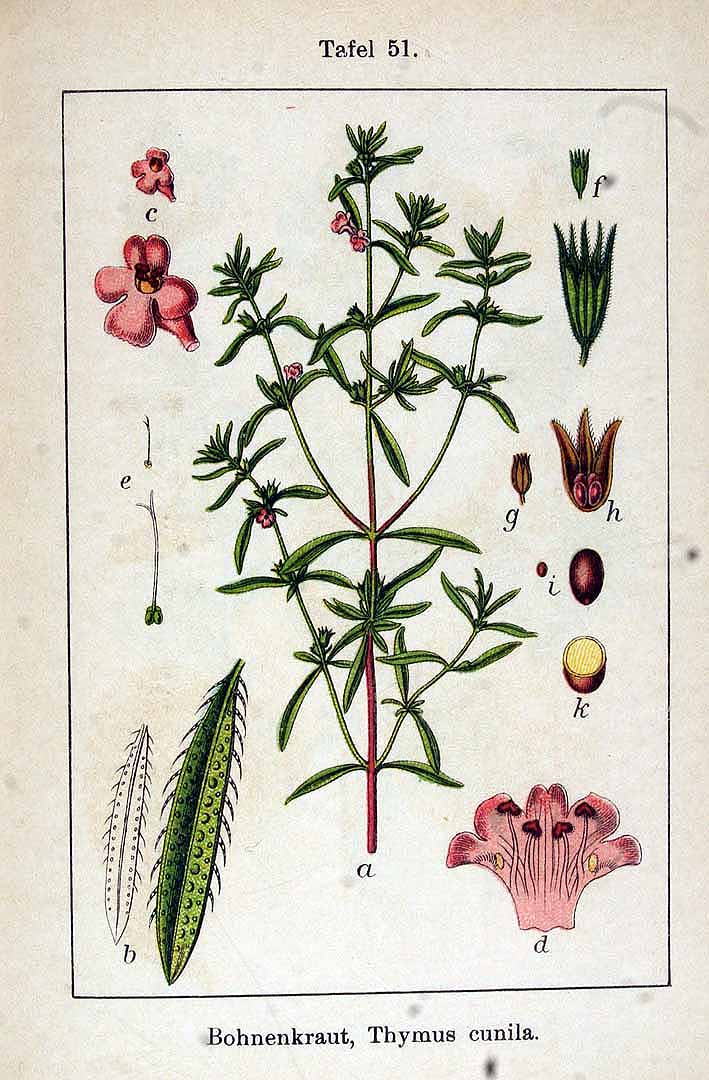
Savory has aromatic and carminative properties and today is mostly used as a culinary herb. It is added to both foods and herbal formulas for its aromatic and warming qualities. Savory’s taste is often compared to thyme (Thymus vulgaris), oregano (Origanum vulgare), and marjoram (Origanum majorana). The 12th-century scholar, mystic, herbalist, and Benedictine abbess Hildegard von Bingen used savory as one of her main culinary herbs in salad dressings and other food preparations (as cited in Strehlow & Hertzka, 1988). It can be used in sausages, stuffing, soups, bean, and cabbage dishes (Castleman, 1991). Savory combines well with marjoram and thyme for turkey, veal, or fish (Grieve, 1931/1971). For individuals on a salt-free diet, savory is a good seasoning because of its spicy flavor. It has been used as a garnish replacing parsley (Petroselinum crispum) and chervil (Anthriscus cerefolium) (Grieve, 1931/1971). Savory can also be added into fresh corn husks before roasting or sprinkled on sliced or broiled tomatoes (Rogers, 2014).
Savory makes a great infused oil or vinegar (Bremness, 1988). At one time, vinegar flavored with savory was used like mint sauce is now (Grieve, 1931/1971) and is also delicious with wine vinegar for salad dressings. Savory also makes a good jelly (Bremness, 1988), syrup, and honey infusion. One can also create a smoke seasoning by throwing a handful on some coals before grilling (Rogers, 2014); when allowed to smoke on a fire, savory creates an aromatic disinfectant (Bremness, 1988). Some say summer savory is sweeter than winter savory, but the two varieties can be used interchangeably in cooking (Castleman, 1991).
Seventeenth-century herbalist Nicolas Culpeper (1653/1814) considered both summer and winter savory to be warming and drying. Like many kitchen herbs, savory has a long history of use for the digestive system, where it has a calming action on overactivity. As a digestive tonic, savory can ease both vomiting and diarrhea, settle indigestion (Bremness, 1988; Madaus, 1938), and stimulate appetite (Bremness, 1988; Rogers, 2014). As a carminative, savory can also be used for excessive flatulence (Grieve, 1931/1971; Felter & Lloyd, 1898). It is also an anthelmintic, supporting the removal of parasitic worms from the digestive system (Madaus, 1938). Savory’s tannic, astringent effect along with its antimicrobial properties further contribute to its helpful actions in cases of diarrhea and acute gastroenteritis (Madaus, 1938; “Savory,” 2007).
Savory is often used for children; it is less powerful than other mints, making it a safe, gentle choice for soothing coughs and tummy aches in little ones (Castleman, 1991). Culpeper (1653/1814) proclaimed there was no better herb than savory for colic. Savory is also especially good at hiding bad-tasting herbs in formulas that children may otherwise refuse (Rogers, 2014).
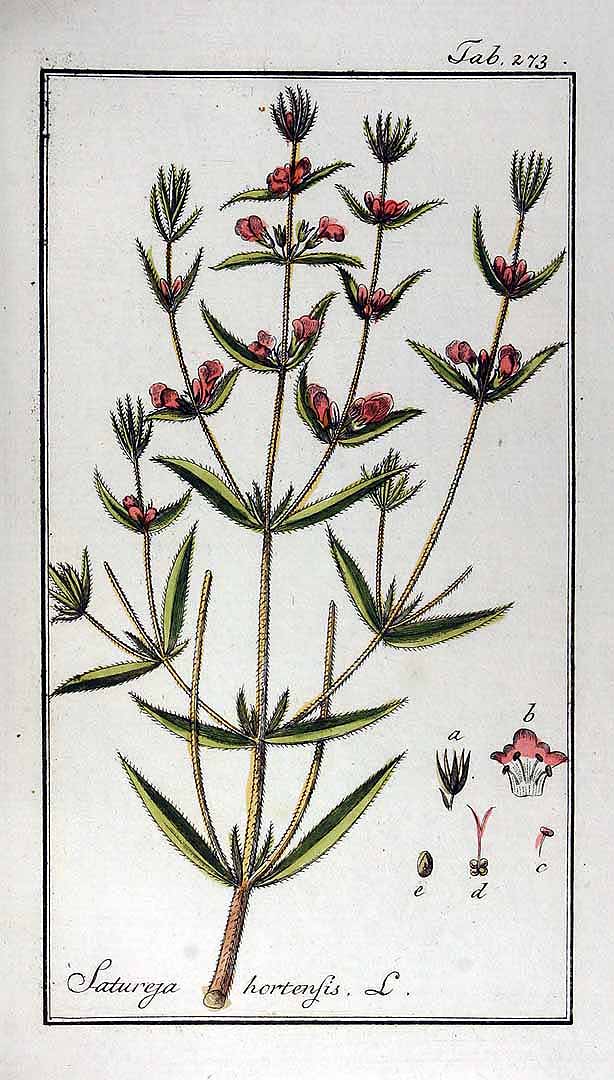
Like other members of the mint family, savory has diaphoretic and expectorant actions, which can be helpful for easing cold and flu (Madaus, 1938; Scudder, 1898; Tierra, 1988). Eclectic herbalist John Scudder (1898) indicated savory specifically for the early stages of fevers and inflammatory conditions, similar to sage (Salvia officinalis), when there is mucus trapped in the lungs. Physiomedicalist William Cook (1869) used savory as a diaphoretic to stimulate perspiration, as well as for measles. All of these recorded uses suggest that savory may have been a general herb for cold and flu, although both Cook (1869) and Scudder (1898) noted it wasn’t commonly used in herbalism. Eclectic herbalists also used savory as a stimulating tonic during the end stages of cold and flu to encourage the return of energy to the body (Felter & Lloyd, 1898).
In a wine tonic, savory is reported to soothe fevers (Bremness, 1988), most likely through its diaphoretic action. In Elizabethan times, savory poultice was applied to the chest for colds and other chest constrictive problems like asthma and congestion (Rogers, 2014). Similar to oregano (Origanum vulgare) and thyme (Thymus vulgaris), savory can be used in baths and inhalations to clear the lungs and nasal passages of mucus. According to Hildegard von Bingen (1158/2001), eating fresh savory strengthens individuals who are sick and weak in their hearts, and also has an uplifting effect on the mind.
For facial steams and baths, savory is antiseptic and astringent, making it particularly good for oily skin (Bremness, 1988). The most common topical use of savory is on wasp and bee stings to soothe pain (Gremness, 1988; Grieve, 1931/1971). Culpeper (1653/1814) suggested the use of savory as a poultice to ease sciatica and palsied limbs. In Iranian folk medicine, savory is used for muscle and bone pain as well as other inflammatory conditions; while the anti-inflammatory and analgesic properties of S. hortensis have been demonstrated in vivo, clinical studies are still needed to confirm these effects in humans (Hajhashemi et al., 2002).
There is no research at this time regarding savory as a sexual stimulant (Castleman, 1991). It was, however, considered to be an emmenagogue by the Eclectics (Felter & Lloyd, 1898) and a uterine tonic by German doctor Gerhard Madaus (1938), who also suggested that internal use of savory should be avoided during pregnancy because of the herb’s effects on the uterus. Herbalist and physician William Cook (1869) also used savory for painful and obstructive menstruation. Modern-day herbalist Michael Tierra (1988) also suggests the use of savory to bring on menses and ameliorate the associated discomfort.
Due to winter savory’s historical use as a sexual depressant, researchers have begun evaluating its potential use for premature ejaculation. While most of the research to date has focused on animal studies, the results have been promising enough that winter savory has now been featured in at least one human clinical trial. Sansalone et al. (2016) found that an herbal compound containing winter savory Satureja montana improved the sexual quality of life for those with premature ejaculation. An international patent has also been registered for the use of winter savory extracts in products for premature ejaculation (Simões Paço & Jorge Pereira, 2016).
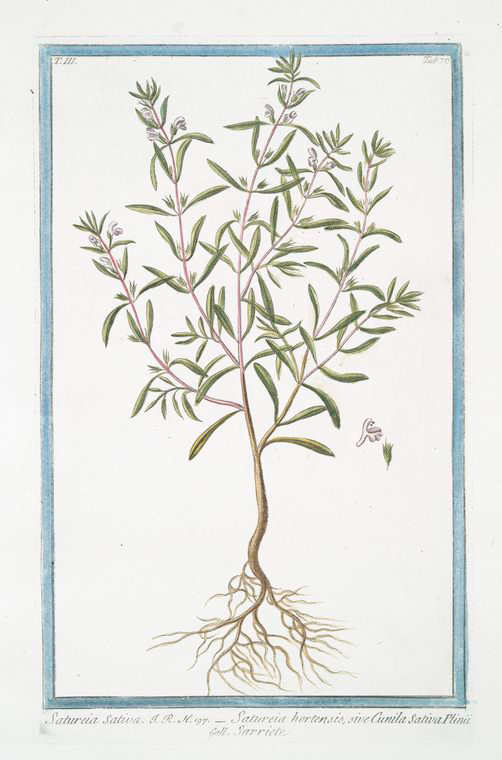
Gerhard Madaus (1938) indicated savory for excessive thirst associated with diabetes. While this particular use has yet to be studied, various Satureja species have been studied for their beneficial effects on symptoms of metabolic syndrome. In a study by Nikaein et al. (2016), capsules of powdered S. hortensis leaf were given to metabolic syndrome patients and the results were compared with those who were given a placebo capsule. Patients who received the savory capsules showed significant reductions in diastolic blood pressure, total cholesterol, triglycerides, and low-density lipoprotein (LDL) cholesterol, with an elevation of high-density lipoprotein (HDL) or “good” cholesterol, when compared to the control group. However, there were no significant changes in blood sugar levels. The researchers concluded that the plant’s antihyperlipidemic, anti-inflammatory, antioxidant, and vasodilatory actions contribute to its efficacy for symptoms of metabolic syndrome (Nikaein et al., 2016).
Savory’s antioxidant action is often attributed to its rosmarinic acid content. Rosmarinic acid is one of the major components in an alcohol extract; one in vitro study found an ethanolic extract to significantly ease oxidative stress from hydrogen peroxide through reducing signaling molecules such as IL-2 and IL-10 that stimulate an inflammatory response (Chkhikvishvili et al., 2013).
Savory is also traditionally used in Iran for thromboembolic disorders (Yazdanparast & Shahriyary, 2008). In a study assessing the effect of summer savory on the cardiovascular system, savory was found to reduce platelet adhesion by 48% at a concentration of 200ug/mL in a methanol extract; the researchers believe that these observations support the traditional use of savory in cases of thrombosis (Yazdanparast & Shahriyary, 2008).
Savory also has a history of use for supporting the function of the eyes and ears. According to Culpeper (1653/1814), “The juice dropped into the eyes removes dimness of sight if it proceeds from thin cold humors distilled from the brain. The juice heated with oil of roses, and dropped into the ears, eases them of the noise and singing in them, and of deafness also” (para. 3). Savory was also used in Germany during the 18th century as an external application for earaches (Madaus, 1938). According to Hildegard von Bingen (1158/2001), savory could also be eaten to help clear the eyes. Modern herbalists still use savory to sharpen the eyesight and ease strain due to tiredness or poor lighting (Rogers, 2014). One animal study found a water extract of summer savory to be effective at reducing inflammation and calming rhinosinusitis symptoms (Uslu et al., 2003). While clinical research to confirm these effects in humans, these preliminary findings along with savory’s known antimicrobial action point to its potential use in a neti pot for nasal congestion.
The Eclectics used savory essential oil as an application for dental caries and toothaches (Castleman, 1991; Felter & Lloyd, 1898). Savory essential oil has also been shown in vitro to be effective at reducing the growth of periodontal bacteria; however, its effects against biofilm formation were limited (Gursoy et al., 2009).
Savory’s antimicrobial action is primarily attributed to its volatile oil content. In a study testing hydrosols of several kitchen spices, Satureja hortensis had the highest antifungal effect tested, reaching 100% eradication on all but two samples (Boyraz & Özcan, 2005). Savory essential oil is now being considered for use as a fungicide for crop production systems to protect organically grown crops (Boyraz & Özcan, 2005). It has also been investigated for use against common food pathogens such as Escherichia coli and Staphylococcus aureus (Rezvanpanah et al., 2011). To expand the use of savory essential oil to this field, its extraction technique has been studied; microwave-assisted hydrodistillation was found to extract essential oil faster than traditional hydrodistillation with the same antibacterial effects on food pathogens (Rezvanpanah et al., 2011). This proposed use will require more testing; on a panel of bacterial and fungal tests, savory was found to be effective for a wide variety of microorganisms that affect humans but much less on plant pathogenic microorganisms (Sahin et al., 2003).
Full Plant Monograph available in The Herbarium website.
For other monograph excerpts, see:
Japanese Knotweed Recipe and Monograph Excerpt
Anise Monograph: Pimpinella Anisum
All About Wild Cherry Bark (Printable Monograph)
REFERENCES
Boyraz, N., & Özcan, M. (2005). Antifungal effect of some spice hydrosols. Fitoterapia, 76(7-8), 661-665. https://doi.org/10.1016/j.fitote.2005.08.016
Bremness, L. (1988). The complete book of herbs: A practical guide to growing & using herbs. New York, NY: Viking Studio Books.
Castleman, M. (1991). The healing herbs: The ultimate guide to the curative power of nature’s medicines. New York, NY: Bantam Books.
Chkhikvishvili, I., Sanikidze, T., Gogia, N., Mchedlishvili, T., Enukidze, M., Machavariani, M., … Rodov, V. (2013). Rosmarinic acid-rich extracts of summer savory (Satureja hortensis L.) protect jurkat T cells against oxidative stress. Oxidative Medicine and Cellular Longevity, 2013, Article ID 456253. https://doi.org/10.1155/2013/456253
Cook, W. (1869). The Physiomedical dispensatory. Retrieved from http://www.henriettes-herb.com/eclectic/cook/SATUREJA_HORTENSIS.htm
Culpeper, N. (1814). Culpeper’s complete herbal and English physician. London, United Kingdom: Richard Evans. (Original work published 1653). Retrieved from http://www.complete-herbal.com/culpepper/wintersavory.htm
Felter, H.W., & Lloyd, J.U. (1898). King’s American dispensatory. Retrieved from http://www.henriettes-herb.com/eclectic/kings/satureja.html
Grieve, M. (1971). A modern herbal (Vol 2). New York, NY: Dover Publications, Inc. (Original work published 1931)
Gursoy, U.K., Gursoy, M., Gursoy, O.V., Cakmakci, L., Kononen, E., & Uitto. V-J. (2009). Anti-biofilm properties of Satureja hortensis L. essential oil against periodontal pathogens. Anaerobe, 15, 164-167. https://doi.org/10.1016/j.anaerobe.2009.02.004
Hajhashemi, V., Ghannadi, A., & Pezeshkian, S.K. (2002). Antinociceptive and anti-inflammatory effects of Satureja hortensis L. extracts and essential oil. Journal of Ethnopharmacology, 82(2-3), 83-87. https://doi.org/10.1016/s0378-8741(02)00137-x
Hamidpour, R., Hamidpour, S., Hamidpour, M., Shahlari, M., & Sohraby, M. (2014). Summer savory: From the selection of traditional applications to the novel effect in relief, prevention, and treatment of a number of serious illnesses such as diabetes, cardiovascular disease, Alzheimer’s disease, and cancer. Journal of Traditional and Complementary Medicine, 4(3), 140–144. https://doi.org/10.4103/2225-4110.136540
Hudz, N., Makowicz, E., Shanaida, M., Białoń, M., Jasicka-Misiak, I., Yezerska, O., … Wieczorek, P.P. (2020). Phytochemical evaluation of tinctures and essential oil obtained from Satureja montana herb. Molecules, 25(20), 4763. https://doi.org/10.3390/molecules25204763
Madaus, G. (1938). Textbook of biological remedies. Retrieved from http://www.henriettes-herb.com/eclectic/madaus/satureja.html
Rezvanpanah, S., Rezaei, K., Golmakani, M-T., & Razavi, S.H. (2011). Antibacterial properties and chemical characterization of the essential oils from summer savory extracted by microwave-assisted hydrodistillation. Brazilian Journal of Microbiology, 42(4), 1453-1462. https://doi.org/10.1590/S1517-838220110004000031
Rogers, M. (Ed). (2014). Herbalpedia: Savory-herb of the year 2015. Retrieved from https://www.herbalpedia.com/SAVORY.pdf
Royal Botanic Gardens of Kew. (n.d.a). Satureja hortensis. Plants of the world online [Database]. Retrieved from http://www.plantsoftheworldonline.org/taxon/urn:lsid:ipni.org:names:457680-1
Royal Botanic Gardens of Kew. (n.d.b). Satureja montana. Plants of the world online [Database]. Retrieved from http://www.plantsoftheworldonline.org/taxon/urn:lsid:ipni.org:names:457736-1
Sahin, F., Karaman, I., Güllüce, M., Oğütçü, H., Sengül, M., Adigüzel, A., … Kotan, R. (2003). Evaluation of antimicrobial activities of Satureja hortensis L. Journal of Ethnopharmacology, 87, 61-65. https://doi.org/10.1016/S0378-8741(03)00110-7
Sansalone, S., Russo, G.I., Mondaini, N., Cantiello, F., Antonini, G., & Cai, T. (2016). A combination of tryptophan, Satureja montana, Tribulus terrestris, Phyllanthus emblica extracts is able to improve sexual quality of life in patient with premature ejaculation. Archivio Italiano di Urologia e Andrologia, 88(3), 171–176. https://doi.org/10.4081/aiua.2016.3.171
Savory. (2007). In Physician’s desk reference for herbal medicines (4th ed., p. 825). Montvale, NJ: Thomson Healthcare.
Scudder, J. (1898). The American Eclectic materia medica and therapeutics. Retrieved from http://www.henriettes-herb.com/eclectic/scudder1898/satureja_stim.html
Shiffler, A. (2019). The complete guide to growing savory indoors. Retrieved from https://herbsathome.co/how-to-grow-savory-indoors/
Silva, F.V., Martins, A., Salta, J., Neng, N.R., Nogueira, J.M.F., Mira, D., … Rauter, A.P. (2009). Phytochemical profile and anticholinesterase and antimicrobial activities of supercritical versus conventional extracts of Satureja montana. Journal of Agricultural and Food Chemistry, 57, 11557-11563. https://doi.org/10.1021/jf901786p
Simões Paço, J., & Jorge Pereira, B. (2016). New therapeutic perspectives in premature ejaculation. Urology, 88, 87–92. https://doi.org/10.1016/j.urology.2015.11.003
Strehlow, W., & Hertzka, G. (1988). Hildegard of Bingen’s medicine. Santa Fe, NM: Bear & Company.
Tierra, M. (1988). Planetary herbology. Twin Lakes, WI: Lotus Press.
Uslu, C., Karasen, R.M., Sahin, F., Taysi, S., & Akcay, F., (2003). Effects of aqueous extracts of Satureja hortensis L. on rhinosinusitis treatment in rabbit. Journal of Ethnopharmacology, 88(2-3), 225-228. https://doi.org/10.1016/s0378-8741(03)00236-8
von Bingen, H. (2001). Hildegard’s healing plants: From her medieval classic physica (Hozeski, B., Trans.). Boston, MA: Beacon Press. (Original work published 1158)
Yazdanparast, R., & Shahriyary, L. (2008). Comparative effects of Artemisia dracunulus, Satureja hortensis and Origanum majorana on inhibition of blood platelet adhesion, aggregation and secretion. Vascular Pharmacology, 48(1), 32-37. https://doi.org/10.1016/j.vph.2007.11.003

